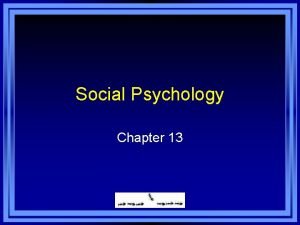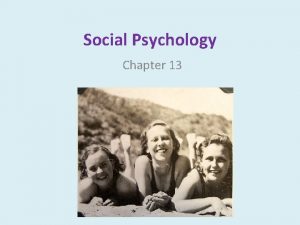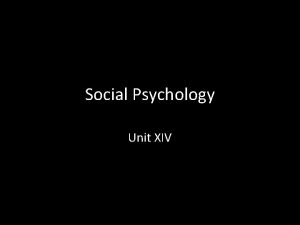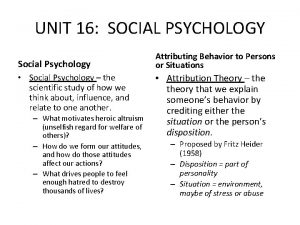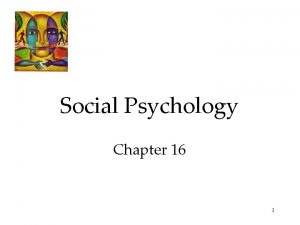Social Psychology Lecture 5 Leadership Chapter 9 Hogg


















- Slides: 18

Social Psychology Lecture 5: Leadership (Chapter 9; Hogg & Vaughan)

At the end of the lecture … • • Personality Emphasis within Social Psychology Types of Leadership Contingency theories Transactional Theories Transformation Theories Leader categorisation theory Social Identity Theory

Personality Traits • Tendency to personify leaders in terms of unique properties or characteristics. . • Social Psychology tells us that people tend to attribute others behaviour to underlying traits • It is not the mere possession of some combination of traits, and other social psychologists have suggested that the search for the leadership personality is simplistic

• The great person theory of leadership , in which effective leaders have special personalities, is generally not well supported. Everyone has the capacity, more or less, to be an effective leader if the situation is right. • Some leadership behaviours or personal qualities may be more effective than others. • Within Social Psychology leadership reflects task or situational demands

Leadership • Autocratic leadership – Organised, gave orders, aloof, focussed on task in hand • Democratic leadership – Calls for suggestions, discussed plans, behaves like other members • Laissez-faire leadership – Leaves the group to its own devices, very low level of intervention

Figure 9. 1 Leadership styles and their effects Source: Based on Lippitt & White (1943)

Leadership • Bales (1950) identified two leadership roles: – socio-emotional leadership – task-oriented leadership. • No one person could occupy both roles • Person filling the task-oriented leadership role would be the dominant leader • Task specialists would be centrally involved, giving direction • Socio-emotional specialists tended to respond and pay attention to feelings of other group members

Leadership: Contingency theory maintains that the leadership effectiveness of particular leadership styles is contingent on situational factors. • Some styles are better suited to some situations or tasks than others • A leader of a country, is different to a leader of an organisation, to a leader on the football field, to a leader in a student workgroup • Fiedler’s contingency theory (like Bales, 1950) distinguished between task-orientated leaders (value group success, get self-esteem from accomplishment) and relationship orientated leaders (relaxed, friendly, sociable) • Where the task is very well or very poorly structured (high versus low situational control), task-oriented leaders do best; otherwise, socio-emotional leaders are best.

Leadership: Other contingency theories • Normative decision theory (Vroom & Jago, 1988). Three decision making strategies • Autocratic (subordinate input not sought) • Consultative (subordinate input not sought but leader retains authority) • Group decision making (leader and subordinates are equal partners) • Outcomes • Autocratic, fast and effective if support from subordinates is present and task is clear. • Where task is not clear, or less support use of other strategies is productive

Leadership: Other models • Limitation of contingency theories is that they are somewhat static. They identify styles, but do little to look at the fluid nature of the work places, this is where other leadership models comes in. – Transactional Leadership: leader-member exchange (LMX) theory – Transformational Leadership: Charisma – Leader categorisation theory – Social Identity approach

leader-member exchange (LMX) theory • According to leader-member exchange (LMX) theory, effective leaders need to establish high-quality personalised relationships with individual group members. • Role taking: The member joins the team and the leader evaluates his or her abilities and talents. Leader may offer opportunities to demonstrate capabilities. • Role-making: In the second phase, the leader and member take part in an unstructured and informal negotiation whereby a role is created for the member and the unspoken promise of benefit and power in return for dedication and loyalty takes place. Trustbuilding is very important in this stage. • Routinisation: In this phase, a pattern of ongoing social exchange between the leader and the member becomes established. Being a successful member usually includes being similar in many ways to the leader.

Transformational Leadership • Transactional leaders appeal to self-interest, transformational leader inspire followers. • Three components to transformation leadership: – Individualised consideration: Attention to needs of follower’s needs, abilities and aspirations to help raise and improve these. – Intellectual stimulation: Challenging followers’ basic thinking, assumptions and practices to help them develop new practices and thinking – Charismatic/inspiring leadership: provides the energy, reasoning, and sense of urgency that transforms followers.

leader categorisation theory • According to leader categorisation theory, we all have schemas of particular types of leaders • The effectiveness of a leader is a matter of the extent to which the leader matches the appropriate leadership schema with the situation.

social identity approach • Linked to the social categorisation • As people identify more strongly with a group, they pay closer attention to the group prototype (someone or something that serves to illustrate the typical qualities) and identify what or who is most prototypical of the group. • Therefore the person who is most prototypical of the group is likely to become a leader, or a leader who maintains attitudes and behaviours consistent with the prototype will be successful

Leader effectiveness as a function of group prototypicality of the leader and salience of the group Figure 9. 4 Source: Based on data from Hains, Hogg & Duck (1997)

Applied Context 9. 1 Norm talk and identity entrepreneurship

Revision Advice • Identify core frameworks from the reading, and furnish with explanation.

At the end of the lecture … • • Personality Emphasis within Social Psychology Types of Leadership Contingency theories Transactional Theories Transformation Theories Leader categorisation theory Social Identity Theory
 Dr ryan hogg
Dr ryan hogg Groupthink vs group polarization
Groupthink vs group polarization Social psychology lecture
Social psychology lecture 01:640:244 lecture notes - lecture 15: plat, idah, farad
01:640:244 lecture notes - lecture 15: plat, idah, farad Fundamental attribution error ap psychology
Fundamental attribution error ap psychology Social psychology is the scientific study of
Social psychology is the scientific study of Social thinking and social influence
Social thinking and social influence Social thinking social influence social relations
Social thinking social influence social relations Forensic psychology lecture
Forensic psychology lecture Introduction to psychology lecture
Introduction to psychology lecture Psychology lecture for medical students
Psychology lecture for medical students Transactional leadership
Transactional leadership Adaptive leadership vs situational leadership
Adaptive leadership vs situational leadership Adaptive leadership vs situational leadership
Adaptive leadership vs situational leadership Social thinking social influence social relations
Social thinking social influence social relations Chapter 12 social psychology
Chapter 12 social psychology Chapter 13 social psychology
Chapter 13 social psychology What is frustration in psychology
What is frustration in psychology Social psychology chapter 1
Social psychology chapter 1
















